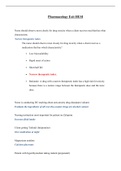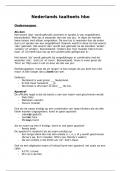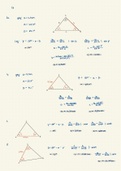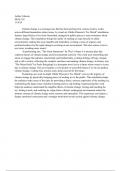Lecture 1
November 15, 2022 9:03 AM
Title: International finance: refresher and introduction
• This course is based on some analytical tools that allow us to dissect the international
financial system. Tools:
WR the 3 analytical • Balance sheets to measure stocks
tools used in the ○ Changes in balance sheets to measure flows
course? WD each
study? • Balance of Payments (BoP) to measure international payment flows
• System of national accounts to measure national macroeconomic flows
WI the use of the
financial system? • The financial system connects surplus and deficit units, nationally and internationally
• This is done by using money
○ Money is changes in balance sheets managed by financial institutions
○ Apart from currencies there are instruments that are not used for
settlement but are part of the hierarchy (i.e.: bonds, derivatives, etc.)
• Balance sheets help you to distinguish buying/selling from investment, and to keep
track of assets and liabilities.
• Financial interactions are interactions between balance sheets
WR the national
accounts (NA)? Key points national financial systems:
• National accounts: system that organizes the national flows (C, I, G, NX)
WI the BoP?
• The BoP is an accounting system to monitor international flows (KA, CA)
WR the 3 key
questions for
national financial • National financial systems are characterized by the answers to three questions:
systems? 1. Who has the power to issue the country’s money?
○ Historically, it is the gov't who has the power to issue it. The gov't licensed
it exclusively to banks (money creation monopoly)
▪ Control by the gov't leads to accruing 'seigniorage': the power to
issue money = free purchasing power.
2. How will the amount of money increase?
○ Lending by banks.
▪ Lending is money creation.
▪ Payment is money transfer.
3. How to balance the demands of money issuers and takers of money?
○ Through double-entry bookkeeping and the legal system around it
(accountants, auditors, reporting standards, valuation rules, bankruptcy
procedures)
WD Mehrling's
hierarchy stress?
Key points the natural hierarchy of money:
• Mehrling's 'hierarchy of money' model connects two opposing theories (scarcity and
elasticity of money). His theory talks about ´how money relate to other financial assets
and liabilities´.
•
Is the moneyness of
an asset fixed? W
determines it?
WI the relation
between money and • Moneyness of an asset is not fixed (and nor is its 'creditness')
credit? ○ It is determined by its ability to be used as means of settlements
Global Finance and Growth Page 1
, ○ It is determined by its ability to be used as means of settlements
WR the dynamics of he • What is money on one level is credit on the next.
system? ○ Lower 'monies' are settled in higher money, but not vice versa
• The money system is hierarchical (not by law, but inherently)
○ The dynamics of the system are the flattening and steepening of the
WR the 2 broad ways hierarchy.
in which the state
can influence the
money supply in the • Government and money:
hands of the private • The gov't has 2 broad ways in which it can change the amount of money (i.e.:
sector? purchasing power, facilitating economic activity) in the hands of the private
sector (i.e.: firms and households)
○ Fiscal policy: raise taxes and spend
▪ The balance of spending and taxing is the net amount of money
injected/drained by the government (i.e.: econ. growth or
contraction)
○ Monetary policy (not done by gov't but by CB): set interest rates, regulate
bank credit.
▪ This influences how much money commercial banks inject in the
WI trade openness?
economy (i.e.: econ. growth)
Key points of the international monetary system
WI KA openness? • Trade openness (open current accounts, CA): allowing imports and exports (and their
payments)
HR int'l transactions • Capital account (KA) openness: allowing non-trade related int'l payments (e.g.:
different from lending, borrowing, investing)
national? (2 things)
• International transactions are different (from national) in that they change int'l
reserves and domestic money supply
•
WR the 4 big issues
in global finance
(and the int'l
monetary system)?
• There are 4 big issues in global finance (and int'l monetary system):
1. What will be the 'money of the world'?
○ In what currency will transaction 3 (in the figure above) take place? What
currency is used to keep int'l reserves?
○ The 'money of the world' is the denomination of reserves.
2. Will exchange rates (XR) be fixed or floating?
○ What is the convertibility between assets/liabilities denominated in
different currencies? What is the rate at which the assets of transaction 2
translate into liabilities of transaction 4?
○ Its XR determines how much local currency (LC) you get for USD ($)
3. Will non-trade capital flows be allowed?
○ Will the CB allow capital to flow in/out? Will transactions 2 and 3 take
place?
○ Free K flows help pay for CA deficits, but also build up income account
revenues/costs
4. What to do with imbalances?
○ What will be the consequence of the int'l exchange of financial
assets/liabilities (perhaps caused by the exchange of goods/services)?
○ (Im)balances may undermine/support continued int'l trade and
investment… or cause a crisis.
Global Finance and Growth Page 2
November 15, 2022 9:03 AM
Title: International finance: refresher and introduction
• This course is based on some analytical tools that allow us to dissect the international
financial system. Tools:
WR the 3 analytical • Balance sheets to measure stocks
tools used in the ○ Changes in balance sheets to measure flows
course? WD each
study? • Balance of Payments (BoP) to measure international payment flows
• System of national accounts to measure national macroeconomic flows
WI the use of the
financial system? • The financial system connects surplus and deficit units, nationally and internationally
• This is done by using money
○ Money is changes in balance sheets managed by financial institutions
○ Apart from currencies there are instruments that are not used for
settlement but are part of the hierarchy (i.e.: bonds, derivatives, etc.)
• Balance sheets help you to distinguish buying/selling from investment, and to keep
track of assets and liabilities.
• Financial interactions are interactions between balance sheets
WR the national
accounts (NA)? Key points national financial systems:
• National accounts: system that organizes the national flows (C, I, G, NX)
WI the BoP?
• The BoP is an accounting system to monitor international flows (KA, CA)
WR the 3 key
questions for
national financial • National financial systems are characterized by the answers to three questions:
systems? 1. Who has the power to issue the country’s money?
○ Historically, it is the gov't who has the power to issue it. The gov't licensed
it exclusively to banks (money creation monopoly)
▪ Control by the gov't leads to accruing 'seigniorage': the power to
issue money = free purchasing power.
2. How will the amount of money increase?
○ Lending by banks.
▪ Lending is money creation.
▪ Payment is money transfer.
3. How to balance the demands of money issuers and takers of money?
○ Through double-entry bookkeeping and the legal system around it
(accountants, auditors, reporting standards, valuation rules, bankruptcy
procedures)
WD Mehrling's
hierarchy stress?
Key points the natural hierarchy of money:
• Mehrling's 'hierarchy of money' model connects two opposing theories (scarcity and
elasticity of money). His theory talks about ´how money relate to other financial assets
and liabilities´.
•
Is the moneyness of
an asset fixed? W
determines it?
WI the relation
between money and • Moneyness of an asset is not fixed (and nor is its 'creditness')
credit? ○ It is determined by its ability to be used as means of settlements
Global Finance and Growth Page 1
, ○ It is determined by its ability to be used as means of settlements
WR the dynamics of he • What is money on one level is credit on the next.
system? ○ Lower 'monies' are settled in higher money, but not vice versa
• The money system is hierarchical (not by law, but inherently)
○ The dynamics of the system are the flattening and steepening of the
WR the 2 broad ways hierarchy.
in which the state
can influence the
money supply in the • Government and money:
hands of the private • The gov't has 2 broad ways in which it can change the amount of money (i.e.:
sector? purchasing power, facilitating economic activity) in the hands of the private
sector (i.e.: firms and households)
○ Fiscal policy: raise taxes and spend
▪ The balance of spending and taxing is the net amount of money
injected/drained by the government (i.e.: econ. growth or
contraction)
○ Monetary policy (not done by gov't but by CB): set interest rates, regulate
bank credit.
▪ This influences how much money commercial banks inject in the
WI trade openness?
economy (i.e.: econ. growth)
Key points of the international monetary system
WI KA openness? • Trade openness (open current accounts, CA): allowing imports and exports (and their
payments)
HR int'l transactions • Capital account (KA) openness: allowing non-trade related int'l payments (e.g.:
different from lending, borrowing, investing)
national? (2 things)
• International transactions are different (from national) in that they change int'l
reserves and domestic money supply
•
WR the 4 big issues
in global finance
(and the int'l
monetary system)?
• There are 4 big issues in global finance (and int'l monetary system):
1. What will be the 'money of the world'?
○ In what currency will transaction 3 (in the figure above) take place? What
currency is used to keep int'l reserves?
○ The 'money of the world' is the denomination of reserves.
2. Will exchange rates (XR) be fixed or floating?
○ What is the convertibility between assets/liabilities denominated in
different currencies? What is the rate at which the assets of transaction 2
translate into liabilities of transaction 4?
○ Its XR determines how much local currency (LC) you get for USD ($)
3. Will non-trade capital flows be allowed?
○ Will the CB allow capital to flow in/out? Will transactions 2 and 3 take
place?
○ Free K flows help pay for CA deficits, but also build up income account
revenues/costs
4. What to do with imbalances?
○ What will be the consequence of the int'l exchange of financial
assets/liabilities (perhaps caused by the exchange of goods/services)?
○ (Im)balances may undermine/support continued int'l trade and
investment… or cause a crisis.
Global Finance and Growth Page 2











